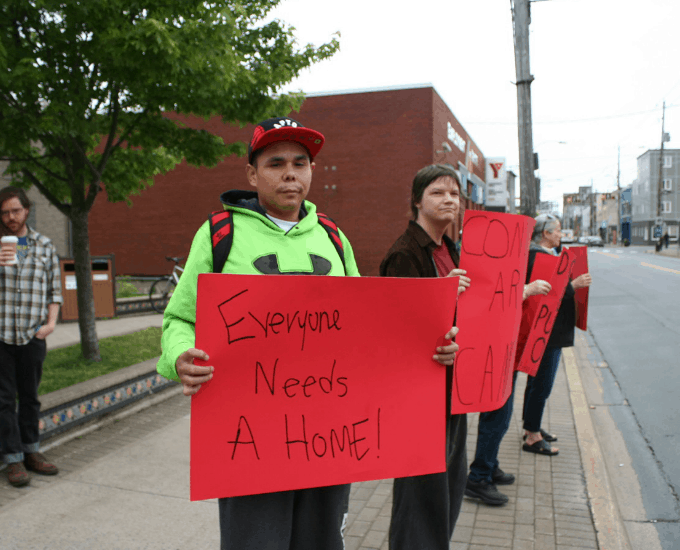
It’s still a long way from election day. There’s another four weeks in which to catalogue the deluge of deceits, deceptions and distortions that inevitably afflict political campaigning. The Conservatives, with their false claim of a “real environmental plan” that will lower greenhouse gas emissions have opened up a big lead. But there are other contenders in the Pinocchio stakes, notably the Liberals’ dubious pronouncements on affordable housing.
A householder from Dartmouth-Cole Harbour Liberal Darren Fisher recently appeared in my community mailbox. It’s a substantial 8-page, double-sided document. Printed in both Official Languages it’s full of pictures and details of worthy local projects that have benefitted from federal funding. But then it enters the realm of misinformation with this statement on the National Housing Strategy:
“Since the launch of our National Housing Strategy, we’ve helped more than 1 million Canadians find a place to call home by investing $7 billion in new builds, repairs, renovations and rental subsidies.”
Well, not actually.
First off, the claim that the National Housing Strategy (NHS) or any other government program has helped more than 1 million Canadians find “a place to call home” rates with the government taking credit for the fact that the sun comes up every morning.
Since the NHS was announced – but not launched – in 2017 the country’s population has increased by about 1 million. It is to be hoped that those additional Canadians have found a home, adequate and affordable or not.
But whether any additions to housing stock result from the National Housing Strategy is highly doubtful. Although it was announced in the 2017 budget, as revealed here at the time, most of the spending – more than 90 per cent of it – will not even start until next year.
As for the $7 billion number, it is made up mainly of funding commitments inherited from the previous Conservative government, topped up by about $2 billion in new money added since 2016.
Strategy under-funded
In these Trumpian days of extreme lying, exposing the sophistry in Darren Fisher’s leaflet may seem like nitpicking. After all, $2 billion’s still a lot of money. And maybe only a policy wonk would care whether the spending is part of the NHS – it’s still going for housing. Fair enough, except for this: the whole National Housing Strategy has been revealed as a public relations exercise that will do little or nothing to increase the supply of affordable housing for Canadians, and Fisher’s leaflet is a case in point.
Not only is the National Housing Strategy many days late, its more than a few dollars short, perhaps even less effective in creating affordable housing than the Harper-era programs it’s replacing.
The latter conclusion emerged from an assessment of the NHS carried out by the Parliamentary Budget Office and released just as the House of Commons was wrapping up in June. The PBO report questioned whether the strategy will have any effect in reducing housing need, concluding that the NHS “largely maintains current funding levels for current activities and slightly reduces targeted funding for households in core housing need.”
In terms of overall spending, the PBO estimates that over the ten fiscal years from 2018-9 to 2027-8 the NHS would spend an average of $2.8 billion a year, 15 per cent higher than the average of $2.4 billion spent over the (mostly Conservative) previous ten years. That modest increase won’t keep pace with inflation. As a result, the share of the economy to be spent on assisted housing is expected to drop to 0.11 per cent of GDP under the NHS, down from 0.13 per cent over the previous 10-year period.
Strategy ineffective
When it was announced, a stated goal of the strategy was to remove 530,000 households from core housing need – that is, households spending 30 per cent or more of income on housing. But the NHS actually reduces amounts targeted to low-income households.
It cuts transfers to provinces as well as funding for federal community housing -including housing for off-reserve Indigenous households – by a combined total of $342 million. Those cuts are offset by $200 million of new spending on rent subsidies and two new programs. These are worth about $680 million a year, but aim mainly at the middle class.
The NHS claims that the major reduction in core housing need – by 300,000 households – will come from rent subsidies. The PBO sees it differently, concluding that the way in which the program is designed will remove “few households” from housing need.
Another 199,300 households are supposed to be removed from housing need through provincial transfers and federal community housing, programs that, as noted above, are reduced under the NHS. Indeed, according to the PBO, the targets under this part of the strategy – 385,000 units protected and 50,000 created – would leave the number of community housing units by 2027-28 below the number that existed in 2017 and more than 160,000 below the number in 2009.
The third major element of the strategy – the $680 million a year in new money and reallocations from transfers and community housing – is projected to create 82,000 housing units. In keeping with the change of emphasis towards the middle class, that investment is projected to remove only 27,600 households from housing need.
Strategy hype
The Liberals initially marketed the NHS it as a $40 billion plan, later inflated to $55 billion with the addition of available loans announced in the 2019 budget. But after stripping out proposed loans, pre-existing spending and unconfirmed provincial cost matching, the PBO reduced the amount of committed federal spending over ten years to $16.1 billion – $14 billion to be spent by Canada Mortgage and Housing Corporation and $2.1 billion by Employment and Social Development Canada.
The latter amount does represent a 60 per cent increase in funding for homelessness programs, perhaps an inadvertent acknowledgement of the Strategy’s shortcomings in creating affordable housing.
As David Hulchanski, a professor of housing and community development at the University of Toronto summed up for the Globe and Mail:
“The housing strategy is a public relations gimmick, assisting fewer low income people than in the past and it is not actually federal spending of $40-billion or $55-billion over 10 years but about $16-billion.”
Local angle
Circling back to Darren Fisher’s householder, affordable housing, especially for renters, is an important issue to voters in Dartmouth-Cole Harbour and the rest of Halifax Regional Municipality, a reality reinforced by two recent reports.
A study released in July by the Canadian Center for Policy Alternatives found that rental rates in HRM are above the national average. The study used “rental wage” as a metric, calculating how much a sole income earner would need to make per hour to avoid housing need. In HRM, the rental wage was found to be $22.57, nearly twice the minimum wage. Nationally the rental wage is $22.40.
And this past week, the federal riding of Halifax cracked the top 20 of 338 federal electoral districts with the highest proportion of renters spending 50 per cent or more of their income on housing. The study by the BC Non-Profit Housing Association estimated 25 per cent of the city’s renters were in this unhappy category. That puts Halifax among other unaffordable “world class” cities like Toronto and Vancouver and explains why rents are going up throughout HRM.
Anyone trumpeting the National Housing Strategy as a solution to the critical shortage of affordable housing is either ignorant of the details or hopeful that voters will fall for the PR pitch.
Richard Starr is a former journalist, civil servant, political hack and seventh generation Nova Scotian. He is devoting his retirement to family, volunteer activities and writing about subjects that interest him and, he hopes, others at Starr’s Point, a Nova Scotia blog where facts matter, where this post was originally published. His most recent book “Equal as Citizens: the tumultuous and troubled history of a great Canadian idea” is about the history of equalization and the fiscal transfer system in Canada and came out in 2014.
With a special thanks to our generous donors who make publication of the Nova Scotia Advocate possible.
Subscribe to the Nova Scotia Advocate weekly digest and never miss an article again. It’s free!



